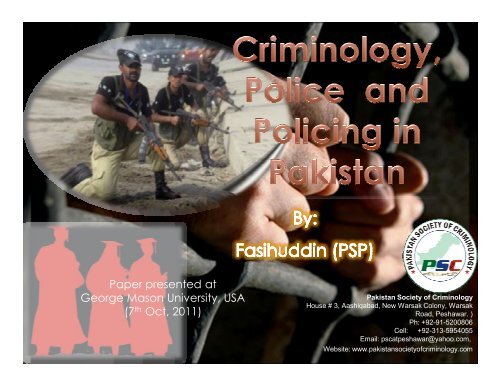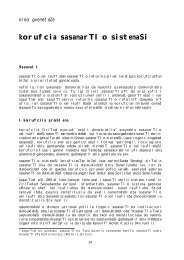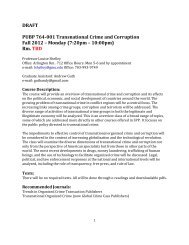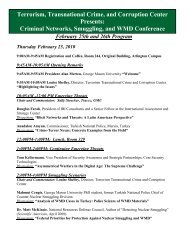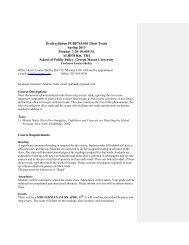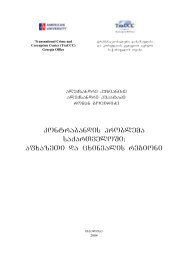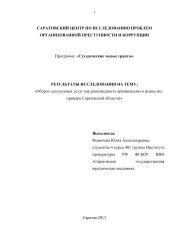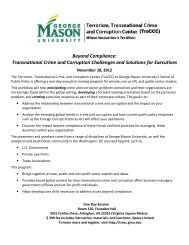Presentation - Terrorism, Transnational Crime and Corruption Center
Presentation - Terrorism, Transnational Crime and Corruption Center
Presentation - Terrorism, Transnational Crime and Corruption Center
You also want an ePaper? Increase the reach of your titles
YUMPU automatically turns print PDFs into web optimized ePapers that Google loves.
Paper presented at<br />
George Mason University, USA<br />
(7 th Oct, 2011)<br />
Pakistan Society of Criminology<br />
House # 3, Aashiqabad, New Warsak Colony, Warsak<br />
Road, Peshawar. )<br />
Ph: +92-91-5200806<br />
Cell: +92-313-5954055<br />
Email: pscatpeshawar@yahoo.com,<br />
Website: www.pakistansocietyofcriminology.com
Pakistan<br />
Population: 177.1<br />
Million Est.<br />
Area: 796,095 sq.<br />
km,<br />
KPK Pop/Area: 23<br />
m/74521 sq.km<br />
FATA Pop/Area:<br />
4.2 m/27220 sq.km
Area (Sq. KM.) 7,96,096<br />
Population<br />
(6 th )<br />
177.1 2010 Population Reference Bureau, 2010<br />
Rural/Urban Ratio 63.2/36.8 2010 Ibid<br />
Life Expectancy at birth (m/f) 67.9/64.18 2010/2011 Economic Survey of Pakistan, 2010-11<br />
Population Growth Rate 2.05% 2010 Population Reference Bureau, 2010<br />
Income Per Capita $1,254 2010-11 Economic Survey of Pakistan, 2010-11<br />
Unemployment Rate 5.6% 2011 Economic Survey of Pakistan, 2011<br />
Below Poverty Line<br />
Educational Expenditure % of<br />
GDP<br />
literacy rate (age +)<br />
Expenditure on health as % of<br />
GDP<br />
Human Development Index<br />
(HDI)<br />
<strong>Corruption</strong> Perceptions Index<br />
Ranking<br />
75% on both<br />
sides of<br />
2011 Economic Survey of Paksitan, 2010-11<br />
Poverty Line<br />
2.10% 2008 ESP-2008-09, Chp. 10. p. 158<br />
56% (69 m, 44<br />
f)<br />
2007-08 ibid<br />
2% WHO (2009). "World Health Statistics.”<br />
128th (0.490) 2010 UNDP, Human Development Report 2010<br />
143/178 2010<br />
Trafficking in Person Tier 2 2010<br />
Transparency International (2011). Global<br />
<strong>Corruption</strong> Perception Index Report 2010<br />
Trafficking in Persons Report 2010 . P.50. US<br />
Department of State.
Total Universities in Pakistan=133<br />
(Public/Private Sector= 74/59).<br />
Universities offering Criminology as subject (3):<br />
1. Karachi University (1996). Master in Criminological Sciences<br />
(MCS)-Evening Programme<br />
2. Sindh University (1998). Department of Criminology. M.Sc.<br />
Criminology – Evening Programme.<br />
3. Punjab University (2009). Institute of Social & Cultural Studies.<br />
M.Sc. Criminology <strong>and</strong> Security Studies (two years) & Diploma<br />
in Criminology (one Year)-Evening Programme.<br />
Note: The degree course of criminology at Punjab University has started in July 2009. Sixty students has got admission in<br />
the first batch of M.Sc. Criminology.
Criminology is also offered as optional subject<br />
in the<br />
<br />
<br />
<br />
<br />
Department of Social Work,<br />
Department of Anthropology &<br />
Department of Sociology, Peshawar<br />
University.<br />
Department of Social Work, Islamia<br />
University Bahawalpur<br />
Department of Social Work, University of<br />
Sargodha.<br />
Department of Social Work <strong>and</strong><br />
Sociology, Kohat University of Science<br />
<strong>and</strong> Technology
HEC Proposed Curriculum for MSc<br />
Criminology<br />
2 years programme.<br />
1 st Semester 2 nd Semester<br />
1 Fundamentals of Criminology 1 Islamic Perspective on <strong>Crime</strong> <strong>and</strong><br />
Punishment<br />
2 Theoretical Perspectives on <strong>Crime</strong> And<br />
Criminal Behaviour<br />
2 Policing<br />
3 Methods of Research in Criminology 3 Forensic Sciences in Criminology<br />
4 Criminal Justice System 4 <strong>Terrorism</strong> <strong>and</strong> Violence<br />
5 Correctional Institutions 5 Criminal Investigation<br />
3 rd Semester 4 th Semester<br />
1 Penology 1 Human Rights<br />
2 Community Justice <strong>and</strong> <strong>Crime</strong> Prevention 2 Criminal Psychology<br />
3 Research Thesis 3 Research Thesis<br />
Source: Revised Curriculum of Criminology (2003)Higher Education Commission, Curriculum Development<br />
Division. Islamabad: Ministry of Education, Pakistan. available at HEC website, www.hec.gov.pk
SINDH UNIVERSITY, JAMSHORO<br />
Two years Post-Graduate Programme<br />
1. CRM 501* Fundamentals<br />
of Criminology<br />
2. CRM 502 Criminal Justice<br />
System<br />
3. CRM 503 Research<br />
Methods<br />
4. CRM 504 Islamic<br />
Perspectives of <strong>Crime</strong>s<br />
5. CRM 505 Juvenile<br />
Delinquency <strong>and</strong> Female<br />
Criminality<br />
6. CRM 506 <strong>Terrorism</strong> <strong>and</strong><br />
Violence<br />
7. CRM 507 Penology<br />
8. CRM 508 Criminal<br />
Psychology<br />
9. CRM 601 Policing<br />
10.CRM 602 Constitution<br />
Rights & Civil Liberties<br />
11.CRM 603 Criminal<br />
Investigation Methods<br />
12.CRM 604 Comprehensive<br />
Viva-Voce<br />
13.CRM 605 Dissertation/<br />
Research Project<br />
*a subject code<br />
Source: Official Website of Department of Criminology, University of Sindh, Jamshoro. Available at www.unisindh.edu.pk
UNIVERSITY OF THE PUNJAB<br />
One Year Diploma in criminology & security<br />
studies<br />
• 1 st Semester • 2 nd Semester<br />
1. <strong>Crime</strong> <strong>and</strong> 1. Research Methods<br />
Criminality: Theory in Criminology<br />
<strong>and</strong> Policy<br />
2. Criminal Law <strong>and</strong><br />
2. Criminal Justice<br />
Penal Code of<br />
System of Pakistan<br />
3. <strong>Corruption</strong> Studies<br />
4. Introduction to<br />
Behavioral Sciences<br />
Pakistan<br />
3. Criminal<br />
Investigation<br />
4. Forensic Science in<br />
Criminology<br />
Note: The degree course in criminology has also started in July 2009.<br />
Source: Official Website of Department of Criminology, University of Punjab. Available at www.pu.edu.pk
UNIVERSITY OF THE PUNJAB<br />
(Cont.)<br />
Master in Criminology & Security Studies is a two-year<br />
program consisting of 4 semesters.<br />
To qualify for the degree, a student should complete 18<br />
courses, Internship <strong>and</strong> Thesis.<br />
• 1 st Semester<br />
1. Introduction to Criminology<br />
2. Introduction to Security<br />
Studies<br />
3. Computer Applications<br />
4. National & International<br />
Perspective on <strong>Crime</strong> <strong>and</strong><br />
Security<br />
5. <strong>Crime</strong> <strong>and</strong> Criminality:<br />
Theory <strong>and</strong> Policy<br />
• 2 nd Semester<br />
1. <strong>Crime</strong> <strong>and</strong> Security<br />
2. Geographical Information<br />
System (GIS)<br />
3. Criminal Justice System of<br />
Pakistan<br />
4. Research Methods in<br />
Criminology<br />
5. Social Statistics in<br />
Criminology<br />
Source: Official Website of Department of Criminology, University of Punjab. Available at www.pu.edu.pk
UNIVERSITY OF THE PUNJAB<br />
(Cont.)<br />
• 3 rd Semester<br />
1. Organizational Behaviour<br />
<strong>and</strong> Human Resource<br />
Development<br />
2. <strong>Crime</strong> <strong>and</strong> Criminology in<br />
Pakistan<br />
3. Islamic Perspective on<br />
<strong>Crime</strong> <strong>and</strong> Punishment<br />
4. Criminal Investigation<br />
5. Community Justice <strong>and</strong><br />
<strong>Crime</strong> Prevention<br />
6. Child Abuse <strong>and</strong> Juvenile<br />
Delinquency<br />
7. Penology<br />
8. Criminal Psychology<br />
9. <strong>Crime</strong> <strong>and</strong> Mental Health<br />
Issues<br />
• 4th Semester<br />
1. Gender <strong>and</strong> <strong>Crime</strong><br />
2. <strong>Terrorism</strong> <strong>and</strong><br />
Violence/Drug Abuse <strong>and</strong><br />
Related <strong>Crime</strong>s<br />
3. Procedures of Evidence in<br />
Criminal Law<br />
4. Forensic Science in<br />
Criminology<br />
5. Policing<br />
6. Organized <strong>Crime</strong> And<br />
Money<br />
7. Laundering<br />
8. Internship<br />
9. Thesis<br />
Source: Official Website of Department of Criminology, University of Punjab. Available at www.pu.edu.pk
KARACHI UNIVERSITY<br />
Two years Masters in Applied Criminology<br />
• 1 st Semester<br />
1. Introduction to Criminal<br />
Behavior<br />
2. Theoretical Perspective<br />
of <strong>Crime</strong> & Criminal<br />
Behavior<br />
3. Research Methodology<br />
in Criminology<br />
4. Principal of Criminal<br />
Law <strong>and</strong> Justice System<br />
5. Correctional Institution<br />
as Social System<br />
• 2 nd Semester<br />
1. Organizational Problem<br />
<strong>and</strong> Management<br />
2. Islamic Perspective on<br />
<strong>Crime</strong> & Punishment<br />
3. Policing & security<br />
4. Forensic Genetics &<br />
Psychology<br />
5. Statistical Methods in<br />
Criminology<br />
Source: Provided by a Master Student of the Criminology, Karachi University.
KARACHI UNIVERSITY (Cont.)<br />
• 3 rd Semester<br />
Core Course<br />
1. <strong>Terrorism</strong>, Violence &<br />
Control<br />
2. Introduction to Criminal<br />
Investigation<br />
3. Research Thesis<br />
Optional Courses (students<br />
are required to select at<br />
least 2 subjects)<br />
1. Drug Abuse <strong>and</strong> Related<br />
<strong>Crime</strong>s<br />
2. Gender & <strong>Crime</strong>s<br />
3. Organized <strong>Crime</strong> <strong>and</strong><br />
Money Laundering<br />
4. Advance Research<br />
Methodology<br />
• 4 th Semester<br />
Core Course<br />
1. Penology<br />
2. Procedure of Evidence in<br />
Criminal Law<br />
3. Research Thesis<br />
Optional Courses (students<br />
are required to select at<br />
least 2 subjects)<br />
1. Mental Health & Issues<br />
2. Child Abuse & Juvenile<br />
Justice System<br />
3. Sentencing as Post<br />
Conviction Strategy<br />
4. Human Rights Law<br />
Enforcement Agencies.<br />
Source: Provided by a Master Student of the Criminology, Karachi University.
AUTHOR’S PROPOSED CURRICULUM OF MSc<br />
CRIMINOLOGY -2 Years<br />
Previous Year (1st Final Year (2nd Year)<br />
Year)<br />
• Previous Year (1st • Final Year (2nd<br />
Year)<br />
Year)<br />
1. Basic Criminology 1. Criminal Justice<br />
2. Criminal Law <strong>and</strong> System<br />
Procedure<br />
3. International <strong>Crime</strong>s<br />
2. Investigation,<br />
Intelligence<br />
<strong>and</strong><br />
4. Police & Policing<br />
5. Criminological<br />
Research<br />
Security Studies<br />
3. Contemporary<br />
Criminology <strong>and</strong><br />
Policing<br />
4. Human Rights<br />
5. Individual Research<br />
Thesis (Tutorial)<br />
6. Viva Voce<br />
Source: Fasihuddin (2008). Exp<strong>and</strong>ing Criminology to Pakistan. Peshawar: Pakistan Society of Criminology.
Professional Organizations<br />
of Criminology in Pakistan<br />
Association of the Police Service of<br />
Pakistan (APSP),<br />
National Council of Criminology Pakistan<br />
(NCCPAK) - http://nucss.edu.pk/index.php<br />
Pakistani chapter of the International<br />
Police Association (IPA). IPA<br />
http://www.ipa-pk.com/<br />
Pakistan Society of Criminology
Total Members (September<br />
2011)= 187<br />
Development of Website<br />
(http://www.pakistansocietyof<br />
criminology.com)<br />
Exp<strong>and</strong>ing Criminology to<br />
Pakistan (Book)<br />
Training to the KPK Police<br />
Training Manuals for Police<br />
Training (Urdu)<br />
Training to the Students of Social<br />
Sciences<br />
Pakistan Journal of Criminology<br />
(PJC), Quarterly, Since April 2009.<br />
Juvenile Justice Review<br />
Criminology Library at Peshawar<br />
Worldwide development of<br />
linkage with the Criminological<br />
Societies<br />
Seminars & Workshops<br />
Proposed National Conference<br />
on Criminology<br />
Urdu Translation of Prof. KCW<br />
book on “Chinese Police”
Police - People Relationship
Police Organization <strong>and</strong><br />
Administration with special<br />
Reference to Recruitment <strong>and</strong><br />
Training<br />
Structure
Sanctioned Police Strength for 2008-09<br />
Rank Punjab Sindh NWFP Balochistan Total<br />
PPO/IGP 1 1 1 1 4<br />
Addl.I.G.P. 18 6 2 4 30<br />
DIG 38 18 13 13 82<br />
AIG/SSP 37 18 10 32 97<br />
SP/Addl.SP 215 102 66 47 430<br />
ASP 65 333 17 5 420<br />
DSP 797 182 222 1201<br />
Inspector 3457 1551 442 542 5992<br />
Sub-Inspector 15121 4190 1779 1545 22635<br />
Assistant Sub-Inspector 12602 9146 1948 2467 26163<br />
Total Officers 32351 15365 4460 4878 57054<br />
Head Constable 17732 15105 6201 7463 46501<br />
Constable 117537 68074 37994 23529 247134<br />
Total Constables 135269 83179 44195 30992 293635<br />
Officer: Constable Ratio 4.18129 5.414 9.909 6.35342353 5.1466<br />
Gr<strong>and</strong> Total 167620 98544 48655 35870 350689<br />
Population<br />
of Pakistan<br />
170 m<br />
Police 350689<br />
Police<br />
Population<br />
Ratio<br />
1:485
Total Police Budget in Pakistan (2008-09)<br />
(Millions Rupees)<br />
Area<br />
Establishment<br />
Other<br />
Expenditure<br />
Development<br />
Total<br />
Punjab 24500.75 4740.84 1375.24 30616.83<br />
Sindh 21521.46 4773.86 500 26795.32<br />
NWFP 5585.622 972.8 636.82 7195.242<br />
Balochistan 3761.38 303.36 0 4064.74<br />
Gr<strong>and</strong> Total<br />
55369.212<br />
(80.6%)<br />
10790.86<br />
(15.7%)<br />
2512.06<br />
(3.6%)<br />
68672.132<br />
(100%)<br />
In US $ 667.098 130.01 30.265 827.375<br />
Source: Office of the Director General, National Police Bureau, Islamabad, Pakistan.
Recorded <strong>Crime</strong>s in Pakistan (1991-2008)<br />
600000<br />
576,185<br />
537,866<br />
Number of Recorded <strong>Crime</strong>s<br />
500000<br />
400000<br />
300000<br />
286,528<br />
323,351 329,305<br />
428,549<br />
388,414<br />
399,006<br />
441,907<br />
538,048<br />
200000<br />
287,746<br />
290,000<br />
339,228<br />
369,161<br />
409,167<br />
380,659<br />
400,680<br />
447,756<br />
100000<br />
0<br />
1991 1992 1993 1994 1995 1996 1997 1998 1999 2000 2001 2002 2003 2004 2005 2006 2007 2008<br />
1 2 3 4 5 6 7 8 9 10 11 12 13 14 15 16 17 18<br />
Years (1991 to 2008)
<strong>Crime</strong> Rate in Pakistan (1991-2008)<br />
Year Population<br />
in Millions [1]<br />
Recorded<br />
<strong>Crime</strong>s [ 2]<br />
<strong>Crime</strong><br />
Rate<br />
1991 112.61 287,746 255.52<br />
1992 115.54 286,528 247.99<br />
1993 118.5 290,000 244.73<br />
1994 121.48 323,351 266.18<br />
1995 124.49 339,228 272.49<br />
1996 127.51 329,305 258.26<br />
1997 130.56 369,161 282.75<br />
1998 133.32 428,549 321.44<br />
1999 136.41 409,167 299.95<br />
2000 139.41 388,414 278.61<br />
2001 142.35 380,659 267.41<br />
2002 145.28 399,006 274.65<br />
2003 148.21 400,680 270.35<br />
2004 151.09 441,907 292.48<br />
2005 153.96 447,756 290.83<br />
2006 156.77 537,866 343.09<br />
2007 159.06 538,048 338.27<br />
2008 162.37 576,185 354.86<br />
Source: [1] Economic Survey of Pakistan 2008-09. Table No. 12.1. p. 194<br />
[2] National Police Bureau, Islamabad, Pakistan
Province-wise <strong>Crime</strong> Figures 2008<br />
Offence Punjab Sindh NWFP Balochistan Total<br />
<strong>Crime</strong> Against Person 52219 19820 10419 3643 86101<br />
Murder 5544 2734 2896 605 11779<br />
Attempt to Murder 7201 3655 2951 625 14432<br />
Hurt 23744 2839 3003 1612 31198<br />
Rioting 270 5208 22 313 5813<br />
Assault on Public Servant 1419 2551 474 205 4649<br />
Zina 2000 206 153 19 2378<br />
Gang Rape 202 49 3 0 254<br />
Kidnapping/Abduction 11279 2168 628 207 14282<br />
Kidnapping for ransom 213 217 129 40 599<br />
Suicide 3 138 11 0 152<br />
Attempt to Suicide 344 55 149 17 565<br />
Traffic Accidents 5306 1482 2676 470 9934<br />
Fatal Accidents 2604 852 707 230 4393<br />
Non Fatal Accidents 2702 630 1969 240 5541<br />
Miscellaneous 100051 15564 23719 1918 141252
Offence Punjab Sindh NWFP Balochistan Total<br />
<strong>Crime</strong> Against Property 81546 24560 2208 2158 110472<br />
Highway Dacoity 73 73 4 42 192<br />
Bank Dacoity 8 20 3 1 32<br />
Petrol Pump Dacoity 13 22 0 5 40<br />
Other Dacoity 2007 2051 53 107 4218<br />
Highway Robbery 230 56 11 5 302<br />
Bank Robbery 17 13 1 1 32<br />
Pet. Pump Robbery 47 77 1 0 125<br />
Other Robbery 13651 5167 171 184 19173<br />
Burglary 11235 2458 518 244 14455<br />
Cattle Theft 7961 684 89 92 8826<br />
M.V. Theft 16343 10525 718 1049 28635<br />
Other Theft 29961 3414 639 428 34442<br />
Total PPC <strong>Crime</strong> 239122 61426 39022 8189 347759<br />
Local & Special Laws 135314 16230 75061 1821 228426<br />
Arms Act 64113 10084 31603 883 106683<br />
Prohibition Order 48048 4816 27222 556 80642<br />
Other Local & Special<br />
Laws<br />
23153 1330 16236 382 41101<br />
Total Recorded <strong>Crime</strong> 374436 77656 114083 10010 576185<br />
Source: National Police Bureau, Islamabad, Pakistan<br />
Cont:
CRIEM FIGURES OF KPK -2009-2010<br />
OFFENCES 2009 2010 DIFFERENCE<br />
TOTAL Reported <strong>Crime</strong> 114677 136665 +21988<br />
Murder 3195 2956 -239<br />
Attempted Murder 2972 2951 -21<br />
Hurts 2697 3151 +454<br />
Zina (Rape) u/s 376(5,6,10) 69 114 +45<br />
Sodemy (377) 88 124 +36<br />
Kid other then ransom 435 273 -162<br />
Kid Ransom 178 158 -20<br />
Abduction 396 586 +190<br />
Assault on Police 380 265 -115<br />
Assault on others Govt: Servant 168 123 -45<br />
Dacoities 103 81 -22<br />
Robberies 203 151 -52<br />
Burglary 575 566 -9<br />
Theft 880 958 +78<br />
Vehicles Theft 632 621 -11<br />
Vehicles Snatching 366 231 -135<br />
Fatal Accident 658 817 +159<br />
Non Fatal Accident 1667 1915 +248<br />
U/S 279/336 PPC 9875 11263 +1388<br />
Local & Special Law 74394 92359 +17965<br />
Miscellaneous 14746 17002 +2256<br />
Source: SP/Research, Central Police Office, Khyber Pakhtunkhwa, Peshawar, Pakistan
<strong>Crime</strong> Rate of Khyber Pakhtunkhwa for the years<br />
2009 <strong>and</strong> 2010<br />
2010<br />
Population [1] 23,300,000<br />
<strong>Crime</strong>s [2] 136,665<br />
<strong>Crime</strong> Rate 586.55<br />
Population [1] 22,780,000<br />
2009 <strong>Crime</strong>s [2] 114677<br />
2008<br />
<strong>Crime</strong> Rate 503.41<br />
Population [3] 21,856,000<br />
<strong>Crime</strong>s [2] 114,089<br />
<strong>Crime</strong> Rate 522<br />
Source: [1] Population: Ministry of Population Welfare<br />
[2] <strong>Crime</strong>: SP/Research, Central Police Office, Khyber Pakhtunkhwa, Peshawar, Pakistan<br />
[3] Economic Survey of Pakistan 2008-09
NO<br />
PERSON KILLED<br />
PERSON INJURED<br />
OF<br />
YEARS CASES<br />
REGIS Police<br />
TERED<br />
FC Army CIVIL: TOTAL Police FC Army CIVIL: TOTAL<br />
2004 27 6 1 2 4 13 3 3 7 58 71<br />
2005 1 0 0 0 0 0 0 0 0 0 0<br />
2006 38 18 0 0 55 73 24 0 0 121 145<br />
2007 359 62 32 62 253 409 172 89 162 592 1015<br />
2008 524 117 25 52 408 602 256 86 88 885 1315<br />
2009 727 149 22 107 742 1020 360 70 236 2244 2910<br />
2010 252 63 12 37 412 524 197 18 105 1047 1367<br />
TOTAL 1928 415 92 260 1874 2641 1012 266 598 4947 6823<br />
Source: Office of Additional IGP Investigation, Khyber Pakhtunkhwa. Pakistan
DISPOSAL OF TERRORISM CASES in KPK- 2010<br />
Previous under investigation 1099<br />
Cases registered 698<br />
Total 1797<br />
Under investigation 143<br />
Challaned 1654<br />
No. of Previous cases pending in court 643<br />
Total in court 2297<br />
Convicted 20<br />
% age of convicted cases 5%<br />
Acquitted: 410<br />
% age of Acquitted cases 95%<br />
Transfer to other court 48<br />
u/s 512 188<br />
Un-traced 501<br />
No. of cases pending in court 1130<br />
Source: SP/Research, Central Police Office, Khyber Pakhtunkhwa, Peshawar, Pakistan
Criticism on Existing Security<br />
Arrangements in USA<br />
Policing <strong>Terrorism</strong><br />
USA UK Pakistan<br />
9/11 Commission (Nov.2002) Review of<br />
2.5 million pages+1200 Interview + 585<br />
pages Report<br />
Situational Prevention (CCVT, Targethardening,<br />
etc)<br />
No Defined Strategy (L,M,S, Term)<br />
Policing in Multicultural Society Hobson’s Choice Post 9/11<br />
NYPD Special Bureau of 1000 officers ILD + Preventive Detention Political or Military leadership?<br />
ILP/IDP___ (Frank Schmalleger, 2007)<br />
Terrorist-Oriented Policing ? ___<br />
(S.Mastrofski, 2006)<br />
Revision of Training, Deployment,<br />
Communication Strategies <strong>and</strong><br />
Counterterrorism Units (Miachel D.<br />
White, 2007)<br />
Aviation <strong>and</strong> Transportation Security<br />
Act, 2001<br />
US Patriot Act 2001<br />
Homel<strong>and</strong> Security Act 2002<br />
Domestic Security Enhancement Act<br />
2003 (US Patriot Act II)<br />
Intelligence Reform <strong>and</strong> <strong>Terrorism</strong><br />
Prevention Act, 2004<br />
Coordination of 22 Disparate Domestic<br />
Agencies__ Five ‘Directorates’<br />
Expert Emergency Response at the<br />
scene of a terrorist incident<br />
Terrorist Act 2000<br />
No New Departments<br />
No Public Debate<br />
In Camera Session of Parliament Oct<br />
9,08<br />
Anti-<strong>Terrorism</strong> <strong>Crime</strong> <strong>and</strong> Security Act No Homel<strong>and</strong> Security<br />
2001 No New Laws<br />
<strong>Crime</strong> (International Cooperation) Act<br />
2003<br />
Prevention of Terrorist Act UK, London<br />
2005<br />
<strong>Terrorism</strong> Act 2006<br />
“Shoot-to-kill-to-Protect”—“Trust us to<br />
Beat the Bomber”—The 2012 Vision of<br />
Sir Ian Blair, London Metropolitan Police<br />
Chief<br />
Minds <strong>and</strong> Hearts<br />
No Joint Task Force<br />
No Anti-<strong>Terrorism</strong> Centre<br />
No Capacity-building of LEAs<br />
No Reasonable share for LEAs in<br />
Foreign Aid<br />
No Regional Consensus (India,<br />
Afghanistan, Iran)<br />
TTIC, JTTFs, etc/New Defence Strategy Engaging Communities No Research & Analysis
P<br />
I
Police Reforms in Pakistan<br />
1. 1948 Passage of Bill to introduce a Metropolitan System of Policing in<br />
Karachi<br />
2. 1951 Recommendations of Sir Oliver Gilbert Grace, IG Police, NWFP<br />
3. 1961 Police Commission headed by Mr Justice J.B. Constantine<br />
4. 1962 Pay & Services Reorganisation Committee (Justice Cornelius)<br />
5. 1970 Police Commission headed by Major General A.O. Mitha<br />
6. 1976 Police Station Enquiry Committee headed by M.A.K. Chaudhry,<br />
IG Police<br />
7. 1976 Law <strong>and</strong> Order Sub-Committee headed by Ch. Fazal Haque<br />
8. 1976 Police Reforms Committee headed by Rafi Raza<br />
9. 1981 Orakzai Committee on Police Welfare, Promotion <strong>and</strong> Seniority<br />
Rules<br />
10. 1982 Cabinet Committee on the Emoluments of SHOs
11. 1983 Cabinet Committee on Determining the Status of SHOs<br />
Cont.<br />
12. 1983 Sahibzada Rauf Ali Committee<br />
13. 1985 The Police Committee headed by Mr Aslam Hayat<br />
14. 1987 Report of the two-member delegation’s visit to Bangladesh <strong>and</strong><br />
India<br />
15. 1989 Report of the seven-member delegation’s visit to Bangladesh <strong>and</strong><br />
India<br />
16. 1990 Police Reforms Implementation Committee – M.A.K. Chaudhary<br />
17. 1995 Report of the UN Mission on Organised <strong>Crime</strong> in Pakistan<br />
18. 1996 Report of the Japanese Police Delegation on the Police System in<br />
Pakistan<br />
19. 1997 Committee on Police Reforms under the Chairmanship of Interior<br />
Minister<br />
20. 1998 Report of the Good Governance Group on Police Reforms:<br />
Committee Vision<br />
21. 2000 Report of the Focal Group on Police Reforms: NRB Draft 2000<br />
Source: HRCP/CHRI 2010. (2010). Police Organization in Pakistan. Lahore: Human Rights Commission of Pakistan
POLICE ORDER 2002<br />
Police prior to 2002—Colonial Legacy<br />
Extraneous Control through<br />
posting/transfer/promotion, etc<br />
Public distrust<br />
↓Community involvement<br />
Poor Supervisory Role<br />
↑ abuse of authority<br />
↑ opportunistic/institutional corruption<br />
↓ internal police accountability instruments<br />
↓ competence for strategic planning<br />
↑ ceremonial & law <strong>and</strong> order duties<br />
↓ professional st<strong>and</strong>ards<br />
Inadequate Independent oversight<br />
mechanism.
POLICE ORDER 2002<br />
SALIENT FEATURES<br />
1861 Police Act—No more<br />
Police Reorganization on Geographic & Functional<br />
basis<br />
Detailed responsibilities <strong>and</strong> Duties of the Police<br />
Rules for posting of PPO/CCPO/DPO, etc<br />
<br />
Prevention (Watch & Ward) <strong>and</strong> Investigation—<br />
Specialization<br />
Policing Plan<br />
Police Complaint Authority/Commission<br />
Establishment of Public Safety Commission<br />
(National/Provincial/District)<br />
Establishing Criminal Justice Coordination Committee<br />
Rules/guidelines for Regulation, Control <strong>and</strong> Discipline<br />
of the Police<br />
Establishment of National Police Management Board<br />
CPLC
COMPARING POLICE STRATEGIES AND CRIME REDUCTION<br />
Strategy Underlying Hypothesis Effectiveness Evidence<br />
Increase Police<br />
umbers<br />
R<strong>and</strong>om patrol<br />
M<strong>and</strong>atory arrest<br />
Community contact<br />
in general<br />
Contact with young<br />
people<br />
Rapid response<br />
Intelligence-led<br />
policing<br />
Directed patrol<br />
More police=less crime<br />
Deterrence through<br />
police omnipresence<br />
More arrests=less crime<br />
More <strong>and</strong> better<br />
community contact =less<br />
crime<br />
More <strong>and</strong> better contact<br />
with young people =less<br />
crime<br />
The faster the response<br />
to incidents=less crime<br />
Target prolific offences<br />
or offenders, increased<br />
arrest rate=less crime<br />
Focus patrol on ‘hot<br />
spots’ <strong>and</strong> ‘hot times’<br />
=less crime<br />
Inconclusive<br />
Ineffective<br />
Effective in some contexts,<br />
ineffective in others; can<br />
result in defiance<br />
Ineffective<br />
Kelling et al. (1974); Clarke<br />
<strong>and</strong> Hough (1984)<br />
Kelling et al. (1974); Audit<br />
Commission (1996)<br />
Sherman <strong>and</strong> Berk (1984);<br />
Sherman et al. (1992)<br />
Skolnick <strong>and</strong> Bayley (1988);<br />
Trojanowicz <strong>and</strong> Bucqueroux<br />
(1998); Fielding (1995)<br />
Inconclusive Heal <strong>and</strong> Laycock (1987)<br />
Inconclusive<br />
May be effective in some<br />
contexts<br />
May be effective in some<br />
contexts; ineffective in<br />
others (e.g.drugs)<br />
Pate et al. (1976); Coupe<br />
<strong>and</strong> Griffiths (1996)<br />
Audit Commission (1993);<br />
Stockdale <strong>and</strong> Gresham (1995,<br />
1998); Maguire (2000); Innes<br />
(2000); Heaton (2000)<br />
Stockdale <strong>and</strong> Grsham<br />
(1998); May et al. (2000);<br />
Best et al. (2001)<br />
Sources:<br />
997-998<br />
Jordan 1998; Sherman 1992a, 1993; Reiner 2000a: 121-4. (Taken from the Oxford H<strong>and</strong>book of Criminology, 3rd Edition, 2002) Page No.
COMPARING POLICE STRATEGIES AND CRIME REDUCTION<br />
Target repeat<br />
victims<br />
Multi-agency<br />
working<br />
Problemoriented<br />
policing<br />
Zero tolerance/<br />
aggressive<br />
order<br />
maintenance<br />
Proactive<br />
stop/search<br />
Target repeat<br />
victims<br />
Protecting victims =less<br />
crime<br />
Partnership between police<br />
<strong>and</strong> other agencies =less<br />
crime<br />
Analysis of crime patterns,<br />
addressing underlying<br />
causes through solving<br />
problems=less crime<br />
Crackdowns on minor<br />
offences lead to reductions<br />
in more serious offences<br />
Increases in use of stop <strong>and</strong><br />
search powers= decrease in<br />
crime<br />
Protecting victims =less<br />
crime<br />
Effective in some<br />
contexts; ineffective in<br />
others<br />
Inconclusive<br />
Inconclusive<br />
Inconclusive; some support<br />
for ‘broken windows’<br />
hypothesis but aggressive<br />
order maintenance can<br />
generate problems.<br />
Inconclusive; limited effectiveness<br />
in some contexts; perceived as<br />
unfair; low ratio of stops to arrests;<br />
risks public disorder<br />
Effective in some<br />
contexts; ineffective in<br />
others<br />
Forrester et al. (1988); Chenery<br />
et al. (1997); Phillips <strong>and</strong><br />
Sampson (1998)<br />
Weatheritt (1986);<br />
Bowling (1999a: 101-<br />
45); Crawford (1999);<br />
Hughes (1998)<br />
Goldstein (1990);<br />
Leigh et al. (1996)<br />
Wilson <strong>and</strong> Kelling (1982);<br />
Kelling <strong>and</strong> Coles (1996)<br />
Bowling (1999a); Bratton<br />
(1997); Dennis (1997)<br />
Boydstun (1975); Wilson <strong>and</strong><br />
Bol<strong>and</strong> (1978); FitzGerald<br />
(1999); Miller, Bl<strong>and</strong>, <strong>and</strong><br />
Quinton (2000)<br />
Forrester et al. (1988);<br />
Chenery et al. (1997);<br />
Phillips <strong>and</strong> Sampson<br />
(1998)<br />
Sources: Jordan 1998; Sherman 1992a, 1993; Reiner 2000a: 121-4. (Taken from the Oxford H<strong>and</strong>book of Criminology, 3rd Edition, 2002)<br />
Page No. 997-998
1. The W/PPO Visit to Nepal on Juvenile Justice (UNICEF), May,<br />
2008.<br />
2. 1-2 Days Seminars <strong>and</strong> Conferences on Human Rights Issues<br />
(2008-2009).<br />
3. Formation of Police Child Protection Committee (PCPC) on<br />
28 August, 2008.<br />
4. The Chairman PCPC & NPB Officers’ visit to Nepal on<br />
“Juvenile Justice Information Systems, (UNICEF) on Nov, 4-7,<br />
2008).<br />
5. Establishment of Directorate of Human Rights, Conflict<br />
Resolution <strong>and</strong> Peace Making, KPK Police (Sep 3, 2009).<br />
6. The Chairman PCPC visit to Child & Women Protection Unit in<br />
the Philippines (PPA), Jan 12, 2009.<br />
7. Juvenile Justice Reforms Project (JJRP) (UNICEF) March, 2009<br />
(All Branches of CJS).
8. Printing of Registers (26-A & 27-A) by UNIFEM, Save the<br />
Children, Sweden& RDHR (IGP. SO.4. April 22, 2009).<br />
Cont.<br />
9. Data Collection Inauguration on April 24, 2009.<br />
10. PCP Committee (PCPC) Renamed as Police Child & Women<br />
Protection Committee (PCWPC) on 14 May, 2009.<br />
11. MOU for Police Child Protection <strong>Center</strong> with SCS <strong>and</strong> MHR on<br />
13 July, 2009.<br />
12. Pakistan Society of Criminology & Save the Children Sweden<br />
Data Collection Project on 13 August, 2009.<br />
13. Police Child Protection Centre (PCPC)—Warsak Road,<br />
Peshawar, September, 2009.<br />
14. Human Rights-Centre at Police Training College, Hangu, Jan<br />
2011. (PSC+SCS)<br />
15. Replication of PCPC & JJSO/CRC Training by Balochistan<br />
<strong>and</strong> Islamabad Capital Territory Police
Human Rights Friendly Policing<br />
New Concept (Syn: Human Friendly Policing,<br />
Public Friendly Policing)<br />
Responsive, Protective <strong>and</strong> Preserver of human<br />
rights.<br />
Delivered by well-resourced police agencies by<br />
deploying well trained personnel who behave<br />
lawfully <strong>and</strong> humanely with all those who come<br />
in contact with the law.<br />
The police as a protectors of human rights of all<br />
citizens in general <strong>and</strong> of children, women,<br />
elderly, minority <strong>and</strong> deprived of liberty in<br />
particular.
Structural<br />
Dimension<br />
Perpetrator<br />
Responsibility<br />
Weak/Special<br />
Segments of Society<br />
Traditional vs HRFP Model<br />
Traditional Model<br />
Violator of law, Criminal<br />
Sole<br />
None<br />
HRFP Model<br />
Accused Suspected, Human<br />
Being, Enjoys many rights till<br />
conviction<br />
Community, Society, Holistic<br />
Approach<br />
Children, Women, WOP,<br />
Elderly, Minority<br />
Detention Facility Combined<br />
Separate, According to Age<br />
<strong>and</strong> Gender<br />
Police Arrest <strong>and</strong> Detain the offenders Protect Human Rights<br />
Police Torture 3 rd Degree Force +++ None<br />
Complaint Mechanism,<br />
Community Satisfaction,<br />
(Nil)<br />
Public Oversight<br />
Open, Fair <strong>and</strong> Accountable<br />
Scientific Methods of<br />
Police Training &<br />
Focused on Law-Enforcement investigation <strong>and</strong> Human<br />
Education<br />
Rights<br />
Purpose of<br />
Police/Judicial Actions<br />
Punishment, Retribution <strong>and</strong><br />
Revenge<br />
Rehabilitation, Reformation<br />
<strong>and</strong> Reintegration
Recommendations-Task Ahead<br />
Introducing Criminology as a subject in all universities<br />
Expansion of PSC provincial offices to all Provinces be ensured<br />
Independent Institution of Criminology, Research & Policing<br />
Sciences be established<br />
Continuity in Pakistan Journal of Criminology (PJC)be ensured<br />
Developing National Data-base at National Police Bureau<br />
Publication of Existing <strong>Crime</strong> Data in PJC in 2010<br />
Review of Existing Laws & Policies<br />
Developing Criminal Justice Policy/Annual National Police Plan<br />
1 st, National Conference of Criminology
Police - People Relationship<br />
March 2010<br />
This picture is from Faizaabad Rawalpindi where<br />
violent protests from public erupted after the hike<br />
in the fares of public transport.


